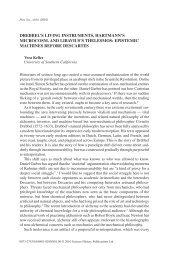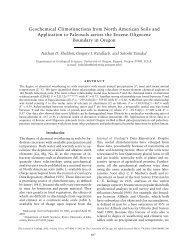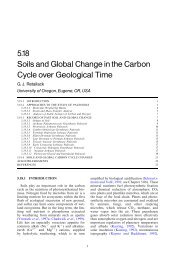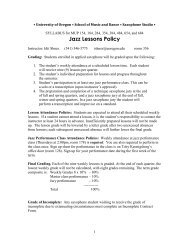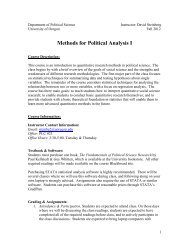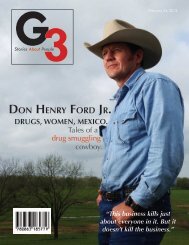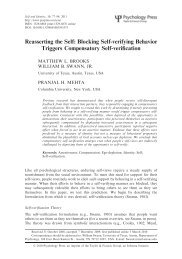Retallack 2007 Proserpina principle - University of Oregon
Retallack 2007 Proserpina principle - University of Oregon
Retallack 2007 Proserpina principle - University of Oregon
Create successful ePaper yourself
Turn your PDF publications into a flip-book with our unique Google optimized e-Paper software.
Record <strong>of</strong> Past Soil and Global Change 15Figure 10Deep clastic dike in a coal <strong>of</strong> the Weller Coal Measures <strong>of</strong> the Allan Hills, Antarctica, interpretedas infill <strong>of</strong> periglacial polygonal patterned ground (E. S. Krull for scale).sedimentary rocks near Lochinvar in southeasternAustralia (<strong>Retallack</strong>, 1999a). Taiga(polar forest) paleosols with discontinuous permafrostdeformation are found in Early Permianred beds near Kiama, also in southeasternAustralia (<strong>Retallack</strong>, 1999b).Milankovitch-scale temporal variation in climateand sea level has long been recognized incyclothemic sedimentation in North Americanpaleotropical Carboniferous marginal marinesequences, and this in turn has been relatedto ice-volume fluctuations on the south polarGondwana supercontinent (Rasbury et al.,1998; Miller and West, 1998). Full glacial coalseams (Histosols) alternating with interglacialmarine rocks are a clear indication <strong>of</strong> thesechanges. Environmental alternations <strong>of</strong> fullglacial,dry, calcareous, swelling-clay soils(Vertisols), and interglacial, wet, decalcified,forest soils (Alfisols) indicate a terrestrialcontribution to multimillenial-scale change inatmospheric greenhouse gases and paleoclimate(<strong>Retallack</strong>, 1995).By Middle Devonian time, the evolution <strong>of</strong>increasingly larger plants culminated in treeswith trunks up to 1.5 m in diameter, whichleave obvious large root traces in paleosols(Driese et al., 1997), as well as abundant permineralizedstumps and logs (Meyer-Berthaudet al., 1999). Middle Devonian paleosols arealso the oldest known with clay-enriched subsurfacehorizons (argillic horizons <strong>of</strong> SoilSurvey Staff, 1999). The clay in modern forestsoils is partly formed by weathering in place,and is partly washed down root holes, whichtaper strongly downward in forest trees. Evidence<strong>of</strong> both ne<strong>of</strong>ormation and illuviation <strong>of</strong>clay can be seen in thin sections <strong>of</strong> Devonianforested paleosols (<strong>Retallack</strong>, 1997b).Latest Devonian paleosols also include coalsfrom the oldest woody peats. Thin peats <strong>of</strong>herbaceous plant remains such as the RhynieChert <strong>of</strong> Scotland (Rice et al., 1995) and theBarzass coal <strong>of</strong> Siberia (Krassilov, 1981) arefound in Early Devonian rocks, but by the latestDevonian (Algeo and Scheckler, 1998) andinto the Carboniferous, woody coals becamewidespread and thick (Figure 9d). Carbon consumptionby accelerated weathering in forestsoils and carbon burial in coals are widely acknowledgedas the likely cause for mass balanceestimates <strong>of</strong> Late Paleozoic highatmospheric oxygen levels (perhaps 35 vol.%)and near-modern CO 2 levels (Berner et al.,2000). Low Permian atmospheric CO 2 levelsare also confirmed by stomatal index studies(<strong>Retallack</strong>, 2001b). These atmospheric trendsand coeval changes in oceanic Mg/Ca ratiocould be attributed to changes in volcanic andhydrothermal activity, particularly at midoceanridges (Stanley and Hardie, 1999).However, the abundance <strong>of</strong> Early Paleozoicpedogenic dolomite, but Late Paleozoic andNeogene pedogenic calcite (<strong>Retallack</strong>, 1985,1993), suggests a role for soils in these changesin oceanic ionic chemistry, as well as inchanging atmospheric CO 2 levels.5.18.3.8 Triassic–Jurassic GreenhousePaleosolsGreenhouse paleoclimates right from thevery beginning <strong>of</strong> the Mesozoic have beenrevealed by discovery <strong>of</strong> deeply weatheredpaleosols in earliest Triassic rocks <strong>of</strong> Antarctica(Figure 11), which even at that time was at



